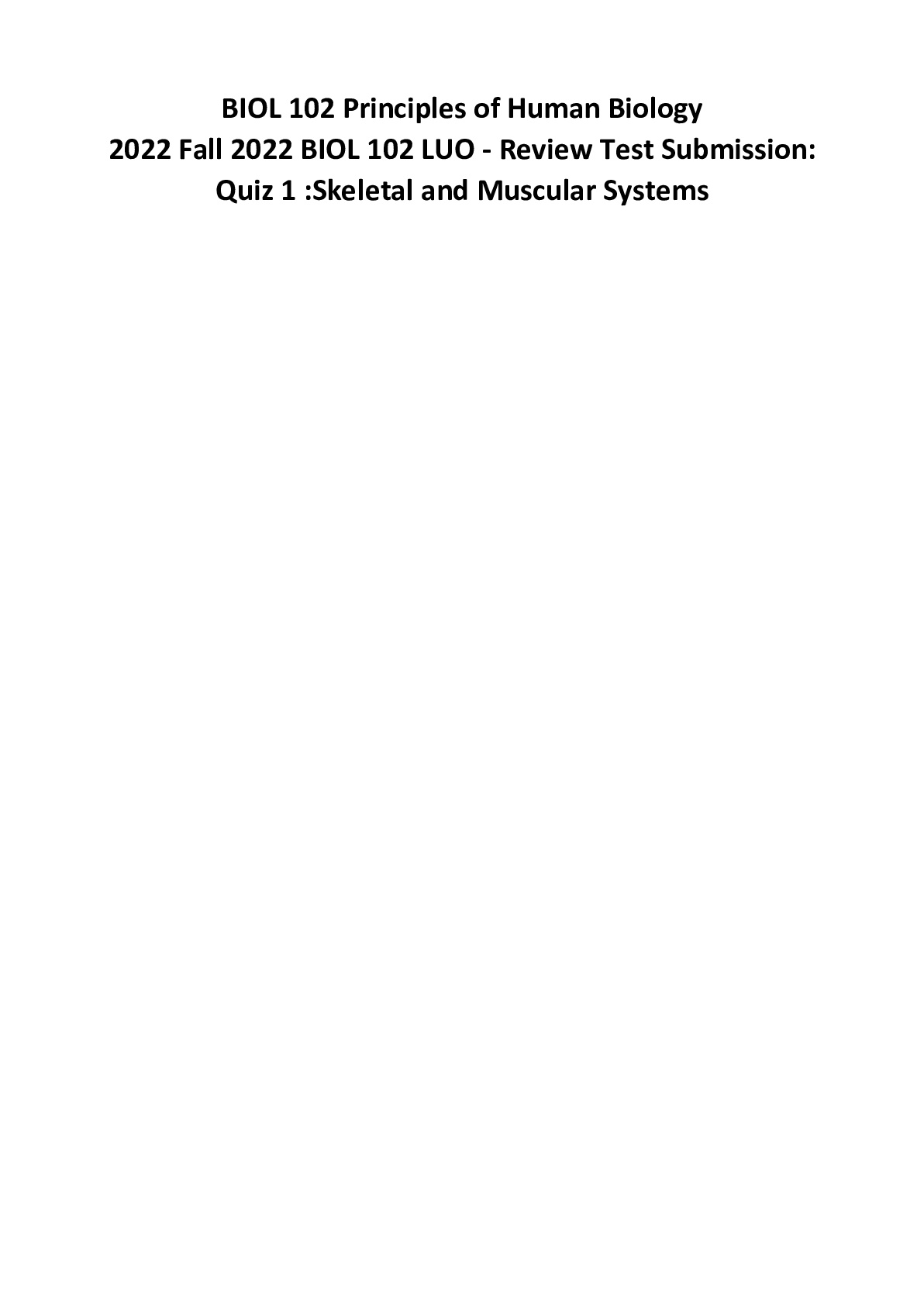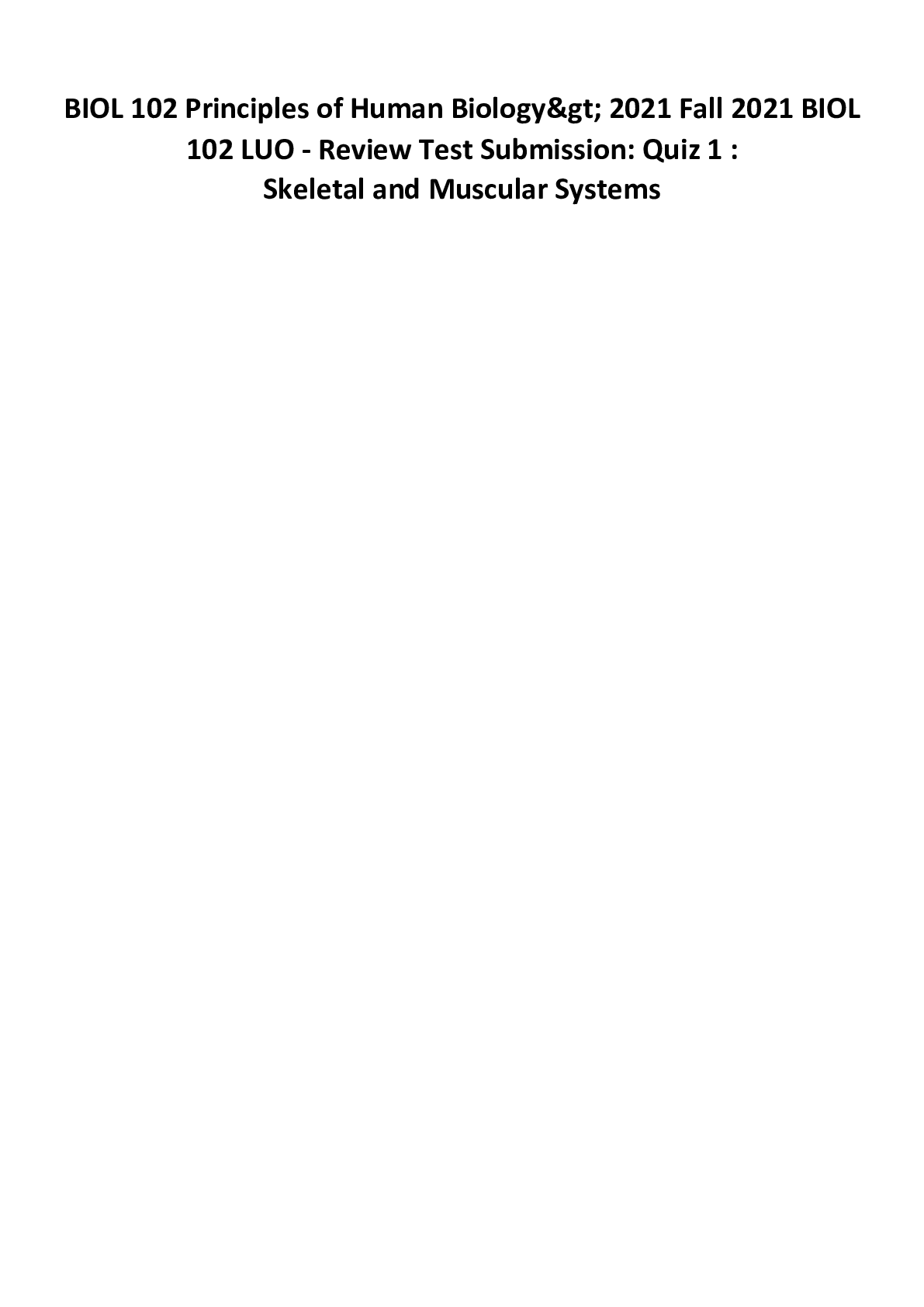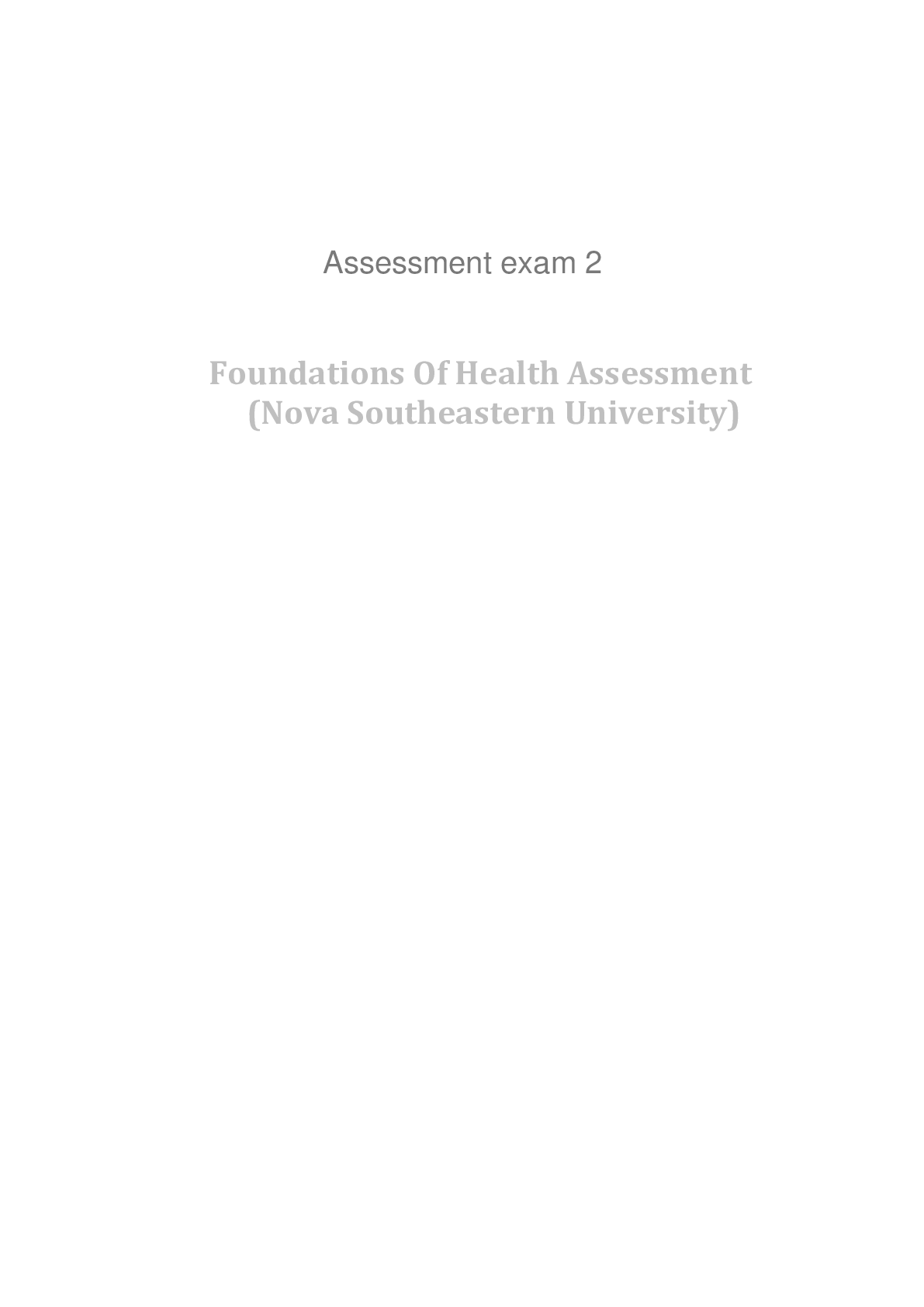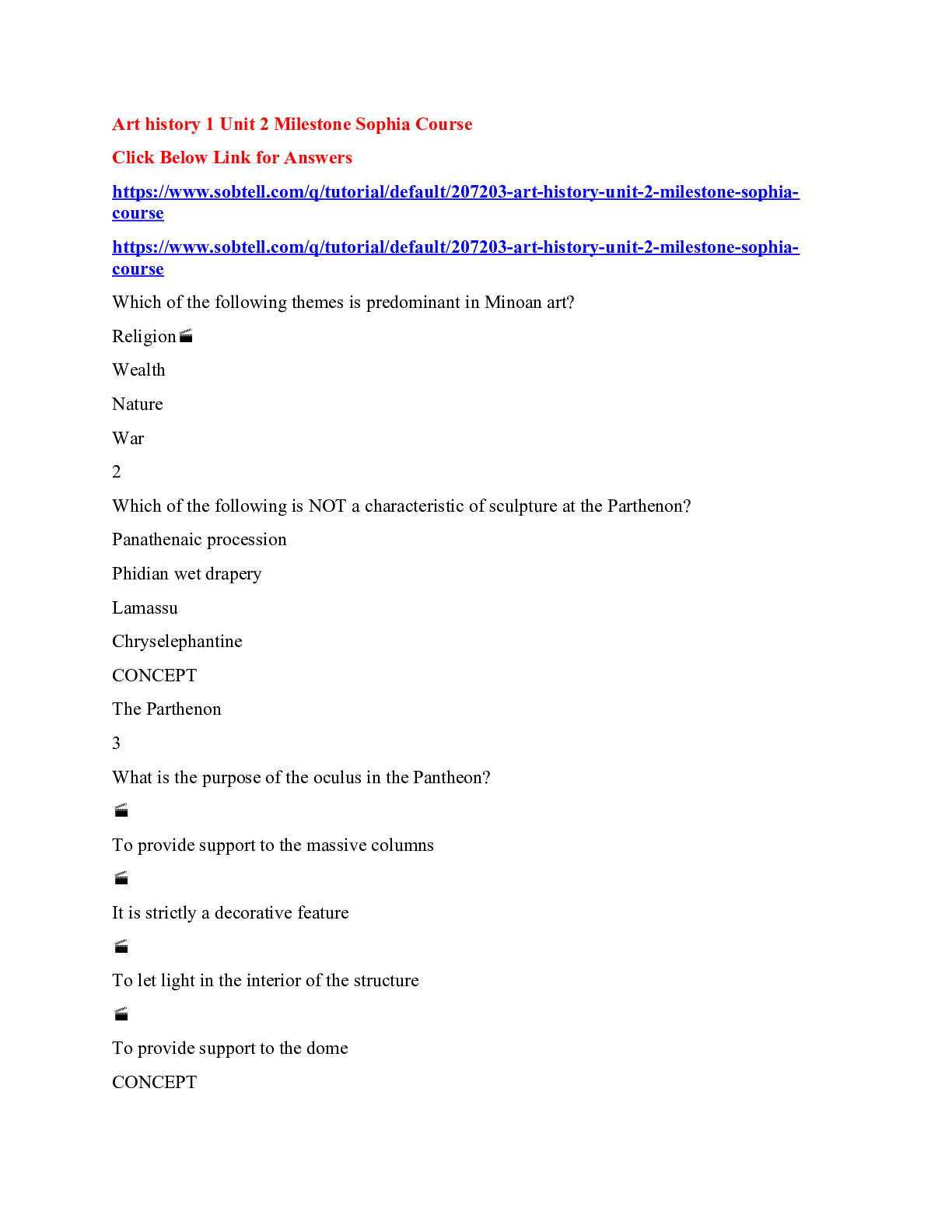*NURSING > EXAM REVIEW > Chapter 03: Psychobiology and Psychopharmacology Halter: Varcarolis’ Foundations of Psychiatric Me (All)
Chapter 03: Psychobiology and Psychopharmacology Halter: Varcarolis’ Foundations of Psychiatric Mental Health Nursing: A Clinical Approach, 8th Edition(Latest Solutions)
Document Content and Description Below
Chapter 03: Psychobiology and Psychopharmacology Halter: Varcarolis’ Foundations of Psychiatric Mental Health Nursing: A Clinical Approach, 8th Edition MULTIPLE CHOICE 29 1. A patient asks, ―... What are neurotransmitters? My doctor said mine are imbalanced.‖ Select the nurse‘s best response. a. ―How do you feel about having imbalanced neurotransmitters?‖ b. ―Neurotransmitters protect us from harmful effects of free radicals.‖ c. ―Neurotransmitters are substances we consume that influence memory and mood.‖ d. ―Neurotransmitters are natural chemicals that pass messages between brain cells.‖ ANS: D The patient asked for information, and the correct response is most accurate. Neurotransmitters are chemical substances that function as messengers in the central nervous system. They are released from the axon terminal, diffuse across the synapse, and attach to specialized receptors on the postsynaptic neuron. The distracters either do not answer the patient‘s question or provide untrue, misleading information. PTS: 1 DIF: Cognitive Level: Understand (Comprehension) REF: Page 3-9 TOP: Nursing Process: Implementation MSC: Client Needs: Physiological Integrity 2. The parent of an adolescent diagnosed with schizophrenia asks the nurse, ―My child‘s doctor ordered a PET. What kind of test is that?‖ Select the nurse‘s best reply. a. ―This test uses a magnetic field and gamma waves to identify problem areas in the brain. Does your teenager have any metal implants?‖ b. ―PET means positron-emission tomography. It is a special type of scan that shows blood flow and activity in the brain.‖ c. ―A PET scan passes an electrical current through the brain and shows brain-wave activity. It can help diagnose seizures.‖ d. ―It‘s a special x-ray that shows structures of the brain and whether there has ever been a brain injury.‖ ANS: B The parent is seeking information about PET scans. It is important to use terms the parent can understand, so the nurse should identify what the initials mean. The correct response is the only option that provides information relevant to PET scans. The distracters describe magnetic resonance image (MRI), computed tomography (CT) scans, and EEG. See relationship to audience response question. PTS: 1 DIF: Cognitive Level: Apply (Application) REF: Pages 3-13, 58 (Table 3-2) TOP: Nursing Process: Implementation MSC: Client Needs: Physiological Integrity 3. A patient with a long history of hypertension and diabetes now develops confusion. The health care provider wants to make a differential diagnosis between Alzheimer‘s disease and multiple infarcts. Which diagnostic procedure should the nurse expect to prepare the patient for first? a. Skull x-rays b. CT scan c. PET 30 d. Single photon emission computed tomography (SPECT) ANS: B A CT scan shows the presence or absence of structural changes, including cortical atrophy, ventricular enlargement, and areas of infarct, information that would be helpful to the health care provider. PET and SPECT show brain activity rather than structure and may occur later. See relationship to audience response question. PTS: 1 DIF: Cognitive Level: Apply (Application) REF: Pages 3-13, 58 (Table 3-2) TOP: Nursing Process: Planning MSC: Client Needs: Physiological Integrity 4. A patient‘s history shows drinking 4 to 6 L of fluid and eating more than 6,000 calories per day. Which part of the central nervous system is most likely dysfunctional for this patient? a. Amygdala b. Parietal lobe c. Hippocampus d. Hypothalamus ANS: D The hypothalamus, a small area in the ventral superior portion of the brainstem, plays a vital role in such basic drives as hunger, thirst, and sex. See relationship to audience response question. PTS: 1 DIF: Cognitive Level: Apply (Application) REF: Pages 3-10, 11 TOP: Nursing Process: Assessment MSC: Client Needs: Physiological Integrity 5. The nurse prepares to assess a patient diagnosed with major depressive disorder for disturbances in circadian rhythms. Which question should the nurse ask this patient? a. ―Have you ever seen or heard things that others do not?‖ b. ―What are your worst and best times of the day?‖ c. ―How would you describe your thinking?‖ d. ―Do you think your memory is failing?‖ ANS: B Mood changes throughout the day may be related to circadian rhythm disturbances. Questions about sleep pattern are also relevant to circadian rhythms. The distracters apply to assessment for illusions and hallucinations, thought processes, and memory. PTS: 1 DIF: Cognitive Level: Apply (Application) REF: Page 3-7 TOP: Nursing Process: Assessment MSC: Client Needs: Psychosocial Integrity 31 6. The nurse administers a medication that potentiates the action of ã-aminobutyric acid (GABA). Which effect would be expected? a. Reduced anxiety b. Improved memory c. More organized thinking d. Fewer sensory perceptual alterations ANS: A Increased levels of GABA reduce anxiety. Acetylcholine and substance P are associated with memory enhancement. Thought disorganization is associated with dopamine. GABA is not associated with sensory perceptual alterations. See relationship to audience response question. PTS: 1 DIF: Cognitive Level: Understand (Comprehension) REF: Pages 3-15, 16, 20, 53 (Table 3-1) TOP: Nursing Process: Evaluation MSC: Client Needs: Physiological Integrity 7. A nurse would anticipate that treatment for a patient with memory difficulties might include medications designed to a. inhibit GABA. b. prevent destruction of acetylcholine. c. reduce serotonin metabolism. d. increase dopamine activity. ANS: B Increased acetylcholine plays a role in learning and memory. Preventing destruction of acetylcholine by acetylcholinesterase would result in higher levels of acetylcholine, with the potential for improved memory. GABA affects anxiety rather than memory. Increased dopamine would cause symptoms associated with schizophrenia or mania rather than improve memory. Decreasing dopamine at receptor sites is associated with Parkinson‘s disease rather than improving memory. PTS: 1 DIF: Cognitive Level: Apply (Application) REF: Pages 3-37, 43, 53 (Table 3-1) TOP: Nursing Process: Planning MSC: Client Needs: Physiological Integrity 8. A patient has disorganized thinking associated with schizophrenia. Neuroimaging would likely show dysfunction in which part of the brain? a. Hippocampus b. Frontal lobe c. Cerebellum d. Brainstem ANS: B The frontal lobe is responsible for intellectual functioning. The hippocampus is involved in emotions and learning. The cerebellum regulates skeletal muscle coordination and equilibrium. The brainstem regulates internal organs. [Show More]
Last updated: 1 year ago
Preview 1 out of 16 pages
Instant download
.png)
Buy this document to get the full access instantly
Instant Download Access after purchase
Add to cartInstant download
Reviews( 0 )
Document information
Connected school, study & course
About the document
Uploaded On
May 04, 2021
Number of pages
16
Written in
Additional information
This document has been written for:
Uploaded
May 04, 2021
Downloads
0
Views
54
.png)



.png)


.png)





.png)

.png)
.png)
.png)
.png)
.png)
.png)
.png)
.png)
.png)
.png)
.png)

